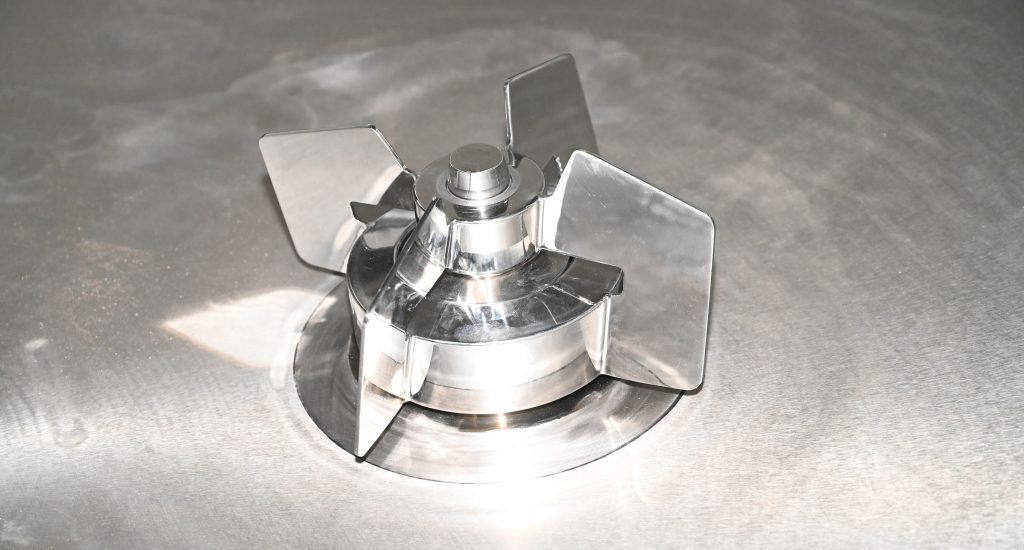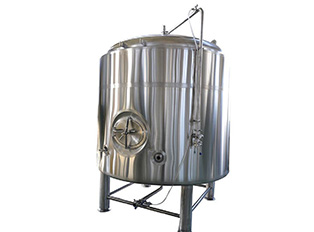

2300 Gallon Mixing Brite Tank
Stainless steel mixing tanks are essential in the food and beverage industry due to their durability, resistance to corrosion, and ease of cleaning. They are versatile tools used in various processes to mix, stir, and maintain the consistency of products.
This 2300 gallon mixing tank uses Magnetic agitator which can mix the liquid more evenly and completely.
Advantages
 |
 |
 |
Magnetic stirring is a widely used technique in laboratory and industrial applications for mixing liquids. It employs a magnetic stir bar placed inside the container and a magnetic field generated by an external stirring device.
Advantages of Magnetic Stirring:
1. Simplified Design and Setup
- Compact and Portable: Magnetic stirrers are typically small and portable, making them easy to integrate into various experimental setups without taking up much space.
- Ease of Use: They require minimal setup, usually just placing a magnetic stir bar in the vessel and positioning it on the magnetic stirring device.
2. Consistent and Uniform Mixing
- Even Distribution: Magnetic stirrers provide consistent and uniform mixing, which is essential for achieving homogeneous solutions, especially in small-scale applications.
- Speed Control: They often come with adjustable speed settings, allowing precise control over the stirring rate to suit different viscosities and mixing requirements.
3. Minimal Maintenance and Cleaning
- No Mechanical Wear: Unlike mechanical stirrers, magnetic stirrers have no moving parts in direct contact with the liquid, reducing the risk of mechanical wear and tear.
- Easy to Clean: The magnetic stir bar can be easily removed and cleaned, and the stirring platform remains free from direct contact with the liquid, simplifying maintenance.
4. Reduced Contamination Risk
- Sealed Environment: Since the stirring mechanism is outside the vessel, there’s no risk of contaminating the liquid with lubricants or wear particles from moving parts.
- Sterility: Magnetic stirring is ideal for sterile and aseptic processes, as it minimizes the potential for contamination, crucial in pharmaceutical and biotechnology applications.
5. Versatility and Application Range
- Wide Range of Vessels: Magnetic stirrers can be used with various container types and sizes, from small laboratory flasks to larger industrial vessels.
- Suitable for Sensitive Reactions: They are well-suited for mixing delicate or temperature-sensitive solutions, where mechanical agitation might cause unwanted heat generation or degradation.
6. Silent Operation
- Low Noise Levels: Magnetic stirrers operate quietly compared to mechanical stirrers, making them more suitable for environments where noise reduction is important, such as in research labs.
7. Enhanced Safety
- No Moving External Parts: The absence of external moving parts reduces the risk of accidents and injuries, making magnetic stirring safer to use, especially in confined or crowded spaces.
- Temperature Control: Many magnetic stirrers come with integrated heating elements and precise temperature controls, allowing safe and controlled heating of the liquid.
8. Energy Efficiency
- Low Power Consumption: Magnetic stirrers typically consume less power compared to larger mechanical stirring systems, making them more energy-efficient for long-term or continuous operations.
9. Non-Intrusive
- Gentle Mixing: The magnetic stir bar provides a gentle mixing action, which is beneficial for sensitive samples or when working with fragile materials that could be damaged by more vigorous stirring methods.
- Unobstructed View: Since there are no external stir rods or paddles, the contents of the vessel remain unobstructed, allowing for better visual monitoring of the process.
In summary, magnetic stirring offers a range of benefits including simplicity, consistent mixing, reduced contamination risk, versatility, and energy efficiency, making it an excellent choice for various applications where gentle and precise mixing is required.
Parameter
 |
 |
 |
 |
Specification of the 2300 gallon mixing tank
- Sanitary Stainless steel 304,
- Effective capacity: 8800L; total volume: 10630L
- Dome top headand bottom; Surface polished, welding line polish sanding light belt;
- Polyurethane insulation, thickness: 80mm; inner body thickness 3mm, cladding thickness 2mm;
- Dimple plate cooling jackets, on wall and bottom;
- Sidemanway;
- With rotary CIP spray balls and arm;
- PT100 temperature sensor;
- 5”Sample valve in the cylinder;
- Working pressure: 2 bar;
- 2”PVRV on top head: 2 bar;
- With 5”inlet port on tank top and inlet pipe
- Pressure gauge;
- With carbonation stone and 1.5”port
- With liquid level tube
- 2”bottom drain pipe
- Glycol solenoid valve
- 2 ladder hooks, 4 stainless steel legs with screw assembly to adjust leg height
- With magnetic agitator and SEW brand motor/reduction gear on tank bottom, motor will be configured as 208V/60Hz/3 phase, VFD speed controllable, motor power: 3KW
- With liquid level sensor port and IFM liquid level sensor



 Contact
Contact
 E-mail
E-mail


 Message
Message












